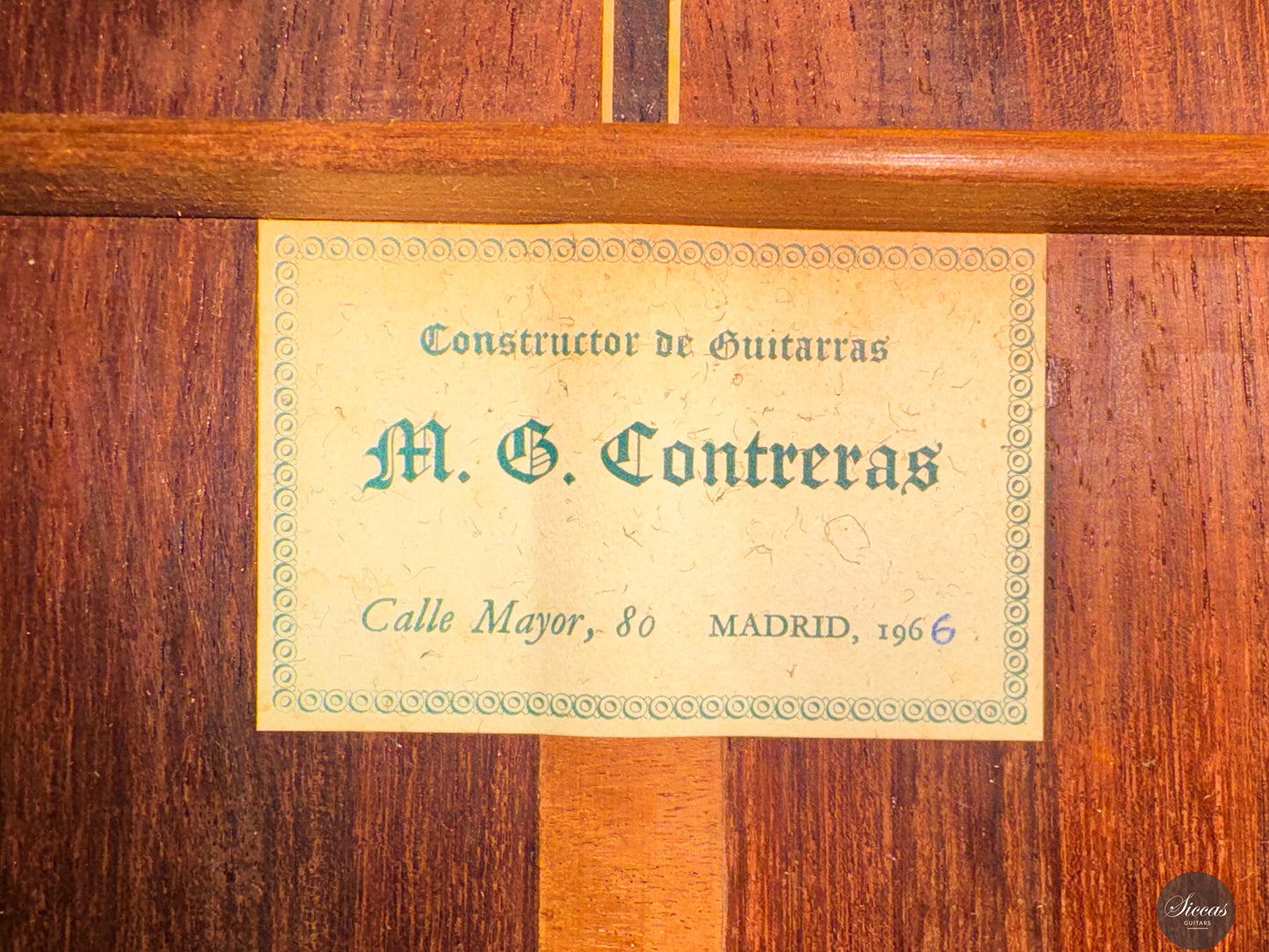Manuel Contreras I - 1966 - 66 cm
Manuel Contreras I - 1966 - 66 cm
Details
Details
Overview
Overview
Shipping important note
Shipping important note
Delivery times are typically reliable and most instruments arrive within the estimated timeframe.
Should any unexpected delay occur, our team will keep you informed and provide support at every step. For all shipping details and exceptions, please see our Shipping Policy.
Details about GPSR
Details about GPSR

























Video overview


More details about the guitar
About the luthier
Manuel González Contreras (1928–1994) was one of the most significant Spanish guitar makers of the 20th century. Initially trained as a cabinetmaker, he entered the guitar world under the guidance of José Ramírez III, working in his workshop between 1959 and 1962. He then founded his own workshop, where he would develop a distinctive approach to classical guitar construction. His legacy was continued by his son Pablo Manuel Contreras (1957–2011), making the Contreras name synonymous with refined craftsmanship and Spanish tonal identity. A comprehensive feature in Orfeo Magazine No. 3 offers valuable insights into their contributions to lutherie.About the guitar
This 1966 classical guitar by Manuel Contreras I is a fine early example of his independent work, constructed just four years after the opening of his own workshop. Built in the traditional style, it features a 660 mm scale length paired with a spruce top and Indian rosewood back and sides, producing a vibrant and resonant sound with excellent tonal separation. The guitar weighs only 1445 grams, making it exceptionally lightweight and highly responsive with a quick and articulate attack. The woods are beautifully grained, showcasing both the visual refinement and careful material selection typical of Contreras’ craftsmanship. The air body resonance lies between F# and G, which complements its bright and punchy sonic profile. The guitar retains its original Fustero tuners, adding to its authenticity and value. Notably, the instrument exhibits a strong Spanish identity with crisp basses and brilliant clarity across the registers, embodying the classic aesthetic and sound palette for which Contreras became known.Condition
This guitar is in excellent condition, remarkable for an instrument of its age. It has been carefully maintained and retains its structural integrity and tonal vibrancy.Regular care extends the life of the instrument
Even with careful use, a classical guitar may gradually change in appearance or respond to unstable storage conditions. Have a close look at your guitar regularly and be attentif to changes. If your instrument is suffering from its environement, it will let you know.
Protect Your Guitar: Handle with Care
Be mindful when touching your instrument with greasy or unwashed hands: any skin contact is a small attack on the varnish. Of course, a guitar is made to be played, but taking a few precautions helps preserve its beauty: wash your hands before playing, wear long sleeves, and avoid unnecessary direct skin contact with the body of the instrument.
Pro tip: Avoid playing with a button-up shirt, heavy jewelry, or a belt, as these can scratch the guitar. Also, make sure your guitar case is free of any objects that could damage the instrument during storage.
String care
A good habit to adopt is wiping down your strings briefly after each playing session. This small action significantly extends their lifespan and helps maintain a consistent, comfortable feel under your fingers.
Most importantly, clean strings are essential for keeping your instrument in tune. Corrosion, sweat, and dust can affect the uniformity of the strings and interfere with accurate tuning across the entire fingerboard.
Pro tip: If you're having trouble getting your guitar in tune, it might be time to change the strings. A useful test is to compare the pitch of the 12th fret harmonic with the fretted note at the 12th fret; if there's an unusually large gap between them, your strings may have lost their integrity and should be replaced.
Keep Your Shellac Finish Shining!
Got a guitar with a shellac (French polish) finish? Here's a simple trick: Take a clean microfiber cloth and gently breathe on the surface to create a light mist. Then, softly rub to remove fingerprints, sweat, and grease. That’s usually all it takes to keep it looking great, no products needed!
Pro tip: Every few years, treat your guitar to a check-up with a luthier to keep it in top shape.
Storing Your Guitar: Climate Matters
Your guitar can safely stay outside its case, as long as the surrounding environment maintains 42–55% humidity and a temperature between 18–25°C.
Keep in mind that humidity levels can still fluctuate inside the case, especially during seasonal changes.
- Too much humidity may cause overtightened strings and a dull tone.
- Too little humidity can lead to a bulging top, string buzz, or even cracks.
Avoid placing your guitar near radiators, air conditioners, or windows with direct sunlight.
Pro tip: Always close your guitar case while playing. This helps preserve a stable microclimate inside the case, so your instrument is protected the moment you put it back in.





















































